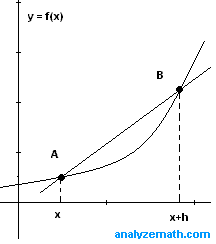 |
| http://www.analyzemath.com/calculus/Differentiation/difference_quotient_1.gif |
The formula for the difference quotient comes from the original, algebraic equation for the slope of the line. When trying to find the slope of a tangent line (one intersection), we must also find the slope of a secant line (two intersections). When you plug in the values of the intersections and combine like terms in the denominator, we are left with with difference quotient.
Sources:
- http://www.analyzemath.com/calculus/Differentiation/difference_quotient_1.gif